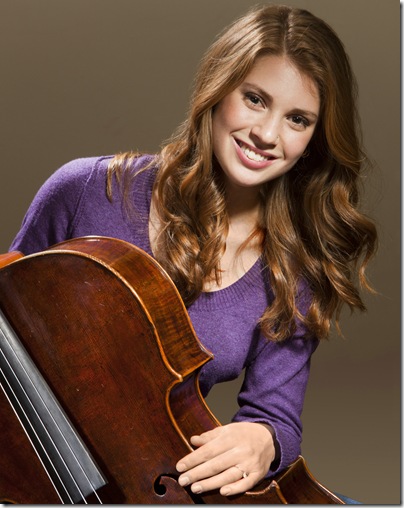The young cellist Cicely Parnas grew up listening to recordings of her celebrated cellist grandfather Leslie, and there’s little doubt that aural education has paid off.
Cicely Parnas, now 23, gave a recital Thursday night at the Eissey Campus Theatre in Palm Beach Gardens, and in everything she played on her program, which consisted of sonatas by Barber, Brahms and Ravel, she demonstrated a classic, beautifully colored cello sound that was at once deeply communicative with her modest audience and completely congruent with the masters of the past.
She began with the Cello Sonata of Samuel Barber (Op. 6), ably accompanied, as she was throughout the brief evening, by pianist Noreen Cassidy-Polera. This is early Barber, but it’s a first-rate piece of neo-Romantic writing, with an instinct for beautiful melodic lines that distinguishes him from most of his compatriots. Why recitalists don’t program it more often, I can’t fathom.
From the first notes of her recital, it was clear that Parnas is a cellist of exceptional technique, a player -whose intonation was spot-on from first to last and who mastered all the most difficult portions of her program with seeming ease. This music’s long-breathed lines all sounded songful and natural, not the product of strenuous effort, so that you had a Barber that sang, particularly in the lovely second subject of the first movement.
She plays with a dark, classic sound that immediately reminds you of the great cellists of the past, but she also is a deeply sensitive musician. She seems to have thought through every musical utterance, so that nothing sounded random or half-baked. In the second movement of the Barber, her tone was full and intense, and in the fast middle section, Polera made the light-hearted, high-register piano part sound like Mendelssohnian fairy dust, all glitter and sparkle.
The finale of this sonata is less direct than the other two movements, but Parnas and Cassidy-Polera were able to find a good dramatic line that ran through it, making it sound at once experimental and compelling.
Parnas followed with the Sonata posthume of Ravel, written in 1897 for violin and then shelved, not to be rediscovered and performed until 1975, 100 years after the composer’s birth. It was later arranged for cello by the German cellist Christian Proske. As Parnas told her audience, the music sounds wholly like the mature Ravel, even though the piece dates from his 22nd year. Some observers have detected the influence of Franck, Faure and Delius in this work, but it speaks with a distinctive voice; indeed, some of its harmonic sequences back up Ravel’s contention that he, not the older Debussy, was first to drink from the impressionist well.
In any case, Parnas played this gorgeous one-movement work exquisitely, completely in harmony with its uniquely Ravelian hothouse fervor, and with flawless intonation that the precision of this music demands. But her playing, with Cassidy-Polera’s splendid accompaniment, also had real personality; the first big outburst of the full triplet-dominated main theme was fiery and passionate, and surely secured the Eissey audience’s attention for the rest of the sonata.
This intermissionless recital closed with one of the staples of the literature, the Sonata No. 1 (in E minor, Op. 38) of Johannes Brahms. This was in every way a terrific performance, from the way Parnas brought the first theme in quietly but not too slowly, giving the music some lift instead of sinking into lugubriousness, to the feel of strict counterpoint she gave to the third movement by playing the main theme not just with scrupulous accuracy but also verve, so that the movement didn’t get bogged down in its own thickets of triplets.
The second movement quasi-minuet benefited from Parnas and Cassidy-Polera’s crisp approach in that it was light on its feet but pointed and suave; the effect was one of vigorous elegance rather than consciously archaic remove, and it worked well.
Judging by the evidence at the Eissey, Cicely Parnas is not only a credit to the cello greatness already in her family line, but a marvelous artist in her own right. This was a concert in the Chamber Music Society of Palm Beach’s new Young Concert Artists series, and Parnas, like other wonderfully equipped but very young players, may not yet bring the full flavor of her own personality to her performances.
But she is without question a cellist to watch, someone whose preferred discipline may be chamber music rather than concerti (to extrapolate from the subtlety she brought to Thursday’s recital), and someone you definitely want to hear the next time she comes to town. It’s good news indeed to hear that the Young Concert Artists series will be back next season for a second year, and if there’s room on that series for Cicely Parnas to return, music lovers should be delighted.
